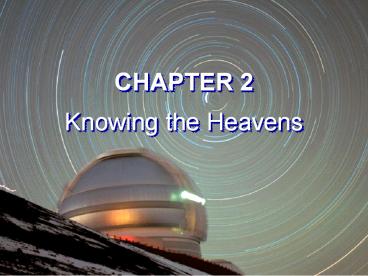Universe 8/e Chapter 2 PowerPoint PPT Presentation
1 / 43
Title: Universe 8/e Chapter 2
1
CHAPTER 2 Knowing the Heavens
2
(No Transcript)
3
What you will learn
- The importance of astronomy in ancient
civilizations around the world - That regions of the sky are divided around groups
of stars called constellations - How the sky changes from night to night
- How astronomers locate objects in the sky
- What causes the seasons
- The effect of changes in the direction of Earths
axis of rotation - The role of astronomy in measuring time
- How the modern calendar developed
4
(No Transcript)
5
(No Transcript)
6
(No Transcript)
7
(No Transcript)
8
(No Transcript)
9
(No Transcript)
10
(No Transcript)
11
(No Transcript)
12
(No Transcript)
13
(No Transcript)
14
(No Transcript)
15
(No Transcript)
16
(No Transcript)
17
(No Transcript)
18
(No Transcript)
19
(No Transcript)
20
(No Transcript)
21
(No Transcript)
22
(No Transcript)
23
(No Transcript)
24
(No Transcript)
25
(No Transcript)
26
(No Transcript)
27
(No Transcript)
28
(No Transcript)
29
(No Transcript)
30
(No Transcript)
31
(No Transcript)
32
(No Transcript)
33
(No Transcript)
34
(No Transcript)
35
(No Transcript)
36
(No Transcript)
37
(No Transcript)
38
(No Transcript)
39
(No Transcript)
40
Key Ideas
- Constellations and the Celestial Sphere It is
convenient to imagine the stars fixed to the
celestial sphere with the Earth at its center. - The surface of the celestial sphere is divided
into 88 regions called constellations. - Diurnal (Daily) Motion of the Celestial Sphere
The celestial sphere appears to rotate around the
Earth once in each 24-hour period. In fact, it is
actually the Earth that is rotating. - The poles and equator of the celestial sphere are
determined by extending the axis of rotation and
the equatorial plane of the Earth out to the
celestial sphere. - The positions of objects on the celestial sphere
are described by specifying their right ascension
(in time units) and declination (in angular
measure).
41
Key Ideas
- Seasons and the Tilt of the Earths Axis The
Earths axis of rotation is tilted at an angle of
about 23.5 from the perpendicular to the plane
of the Earths orbit. - The seasons are caused by the tilt of the Earths
axis. - Over the course of a year, the Sun appears to
move around the celestial sphere along a path
called the ecliptic. The ecliptic is inclined to
the celestial equator by about 23.5. - The ecliptic crosses the celestial equator at two
points in the sky, the vernal (March 21) and
autumnal (September 21) equinoxes. - The northernmost point that the Sun reaches on
the celestial sphere is the summer solstice (June
21), and the southernmost point is the winter
solstice (December 21).
42
Key Ideas
- Precession The orientation of the Earths axis
of rotation changes slowly, a phenomenon called
precession. - Precession is caused by the gravitational pull of
the Sun and Moon on the Earths equatorial bulge. - Precession of the Earths axis causes the
positions of the equinoxes and celestial poles to
shift slowly as seen against the background of
more distant stars. - Because the system of right ascension and
declination is tied to the position of the vernal
equinox, the date of observation must be
specified when giving the position of an object
in the sky.
43
Key Ideas
- Timekeeping Astronomers use several different
means of keeping time. - Apparent solar time is based on the apparent
motion of the Sun across the celestial sphere,
which varies over the course of the year. - Mean solar time is based on the motion of an
imaginary mean sun along the celestial equator,
which produces a uniform mean solar day of 24
hours. Ordinary watches and clocks measure mean
solar time. - Sidereal time is based on the apparent motion of
the celestial sphere. - The Calendar The tropical year is the period
between two passages of the Sun across the vernal
equinox. Leap year corrections are needed because
the tropical year is not exactly 365 days. The
sidereal year is the actual orbital period of the
Earth.

